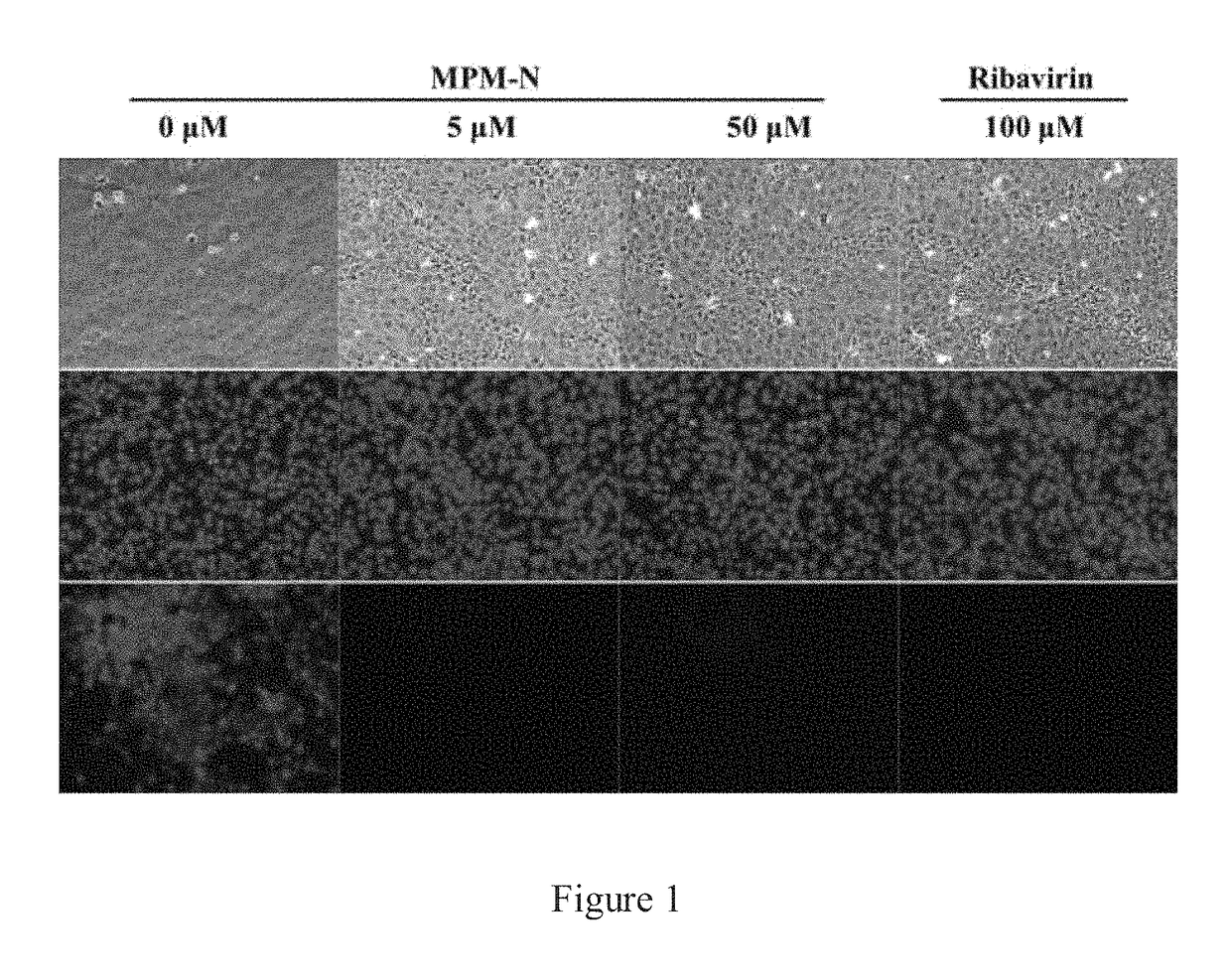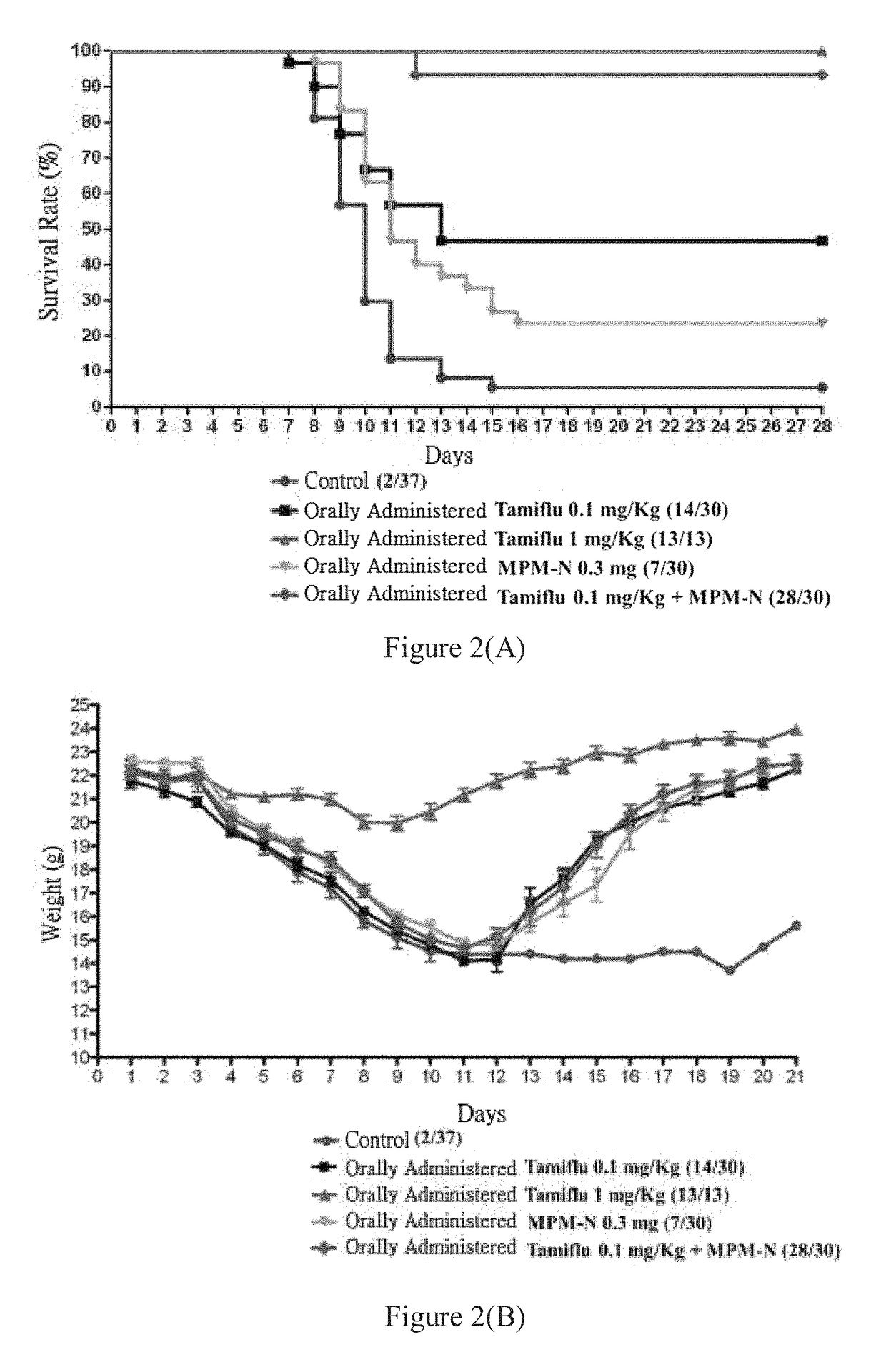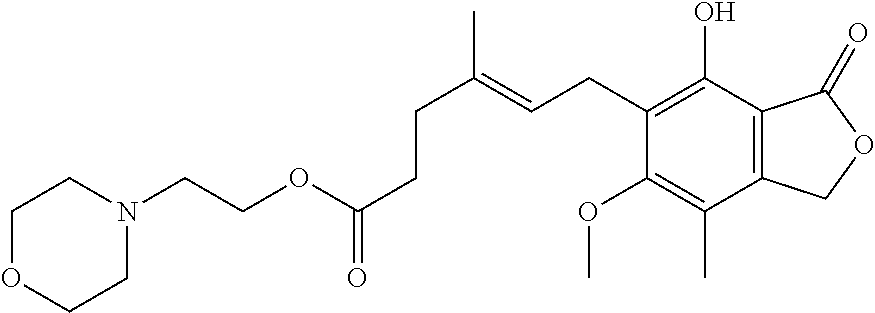Usage of mycophenolate mofetil or salt thereof in preparing drug for resisting against influenza virus
a technology of mycophenolate and mofetil, which is applied in the manufacture of mycophenolate mofetil or a pharmaceutically acceptable salt thereof, and can solve the problems of bronchitis and interstitial pneumonia, its risks, heavy burden on the society, and economic loss
- Summary
- Abstract
- Description
- Claims
- Application Information
AI Technical Summary
Benefits of technology
Problems solved by technology
Method used
Image
Examples
example 1
on of Mycophenolate Mofetil (MPM) and a Hydrochloride Salt Thereof (MPM-N)
[0047]Mycophenolate mofetil can be prepared according to the method as described below: 3.2 g (10 mmol) mychphenolic acid in ice bath was dissolved into 30 ml dichloromethane solution, 1.5 ml (17.5 mmol) oxalyl chloride and two drops of dimethylformamide was added, and the mixture was stirred for 3 hours under room temperature. The mixture was vacuum-evaporated to obtain compound 11b. The preparation process is as follows:
[0048]
[0049]Compound 11b was dissolved into 20 ml ethyl acetate solution, 2.6 ml (20 mmol) 4-(2-hydroxyethyl) morpholine was added, the mixture was stirred under room temperature for 30 minutes and vacuum-evaporated and crude product of mycophenolate mofetil was obtained, then 50 ml water was added and neutralization was done with 0.1 N hydrochloric acid to reach pH 7.0 to facilitate precipitation of pure mycophenolate mofetil compound (4.7 g, 81.0%, mp. 95-96° C.).
[0050]Mycophenolate mofetil...
example 2
tion for Minimal Inhibitory Concentration and Toxicity of the Purified Compounds
[0051]Anti-viral activity test was conducted by determining the level of virus infection in host cells through the host cell survival rate. The host cell survival rate was analysed with MTT assay, based on the theory that 3-(4,5-dimethylthiazol-2-yl)-2,5-diphenyltetrazolium bromide (MTT) yellow solution solids can be metabolized by the dehydrogenases in the mitochondria of live cells, and reduce the tetrazolium ring to form purple insoluble precipitation formazan (3-(4,5-dimethylthiazol-2-yl)-2,5-diphenyl-formazan) and accumulate in the cells. Since only dehydrogenases in live cells have catalysing activity, the absorbance value measured will be proportional with the number of live cells. In this example, the yield of formazan was measured to assess the survival rate of cells.
[0052]In the example, H1N1 and H3N2 were specifically used as viral strains to test the anti-influenza virus activity as detailed ...
example 3
nhibitory Concentration Against Drug-Resistant Virus Strains
[0081]The minimal inhibitory concentration (MIC) of the following compounds against drug-resistant influenza virus variants were determined according to the above-mentioned method.
[0082]MPM: mycophenolate mofetil
[0083]MPM-N: hydrochloride
[0084]Tested influenza viral strains include:
[0085]H1N1 T.R.—Tamiflu-resistant variant of H1N1 viral strain was obtained by variation of Influenza A virus (H1N1), which was found to be similar to Influenza A / Taiwan / 937 / 2009 after sequencing.
[0086]H3N2—Influenza A viral strain (H3N2), which was found to be similar to Influenza A / New York / 469 / 2004 after sequencing.
[0087]WSN—Influenza A / WSN / 33 (H1N1), which was found to be similar to Influenza A / Hong Kong / 470 / 97 after sequencing.
[0088]Influenza B—Influenza B viral strain.
[0089]H1N1—Influenza A viral strain (H1N1).
[0090]
TABLE 4Comparison of the 50% effective concentration (EC50),the 50% cytotoxic concentration (CC50) and the selectionindex (S.I...
PUM
| Property | Measurement | Unit |
|---|---|---|
| pH | aaaaa | aaaaa |
| concentrations | aaaaa | aaaaa |
| concentrations | aaaaa | aaaaa |
Abstract
Description
Claims
Application Information
 Login to view more
Login to view more - R&D Engineer
- R&D Manager
- IP Professional
- Industry Leading Data Capabilities
- Powerful AI technology
- Patent DNA Extraction
Browse by: Latest US Patents, China's latest patents, Technical Efficacy Thesaurus, Application Domain, Technology Topic.
© 2024 PatSnap. All rights reserved.Legal|Privacy policy|Modern Slavery Act Transparency Statement|Sitemap



